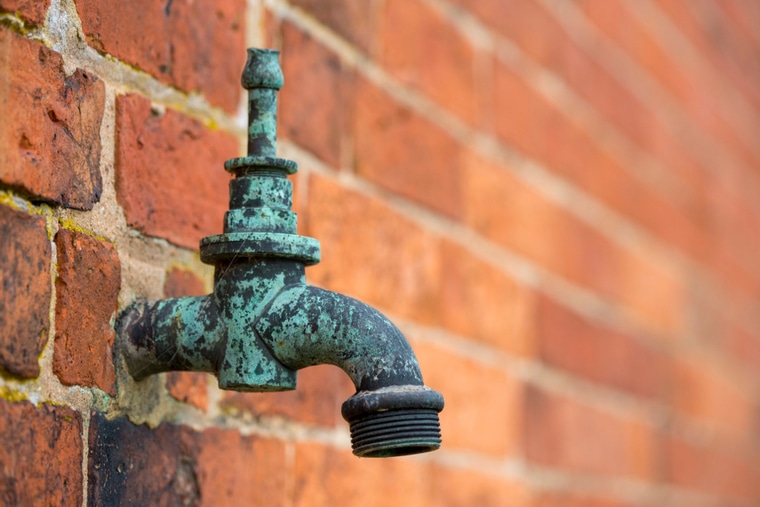Jul 23 2019
Manganese is not categorically a toxic mineral. Actually, people require a little manganese in their diets to keep healthy.
 An old lead and iron tap. New research from the McKelvey School of Engineering demonstrates the role manganese plays in the rate of transformation of lead carbonate to lead dioxide. (Image credit: Washington University in St. Louis)
An old lead and iron tap. New research from the McKelvey School of Engineering demonstrates the role manganese plays in the rate of transformation of lead carbonate to lead dioxide. (Image credit: Washington University in St. Louis)
A new study at Washington University in St. Louis has revealed, however, that along with some other chemicals, naturally occurring manganese can result in huge changes in the water in lead pipes. Based on what disinfectants are applied in the water, those changes can have major—even hazardous—repercussions.
The results have been published in Environmental Science and Technology.
The research concentrates on a distinctive type of lead, lead dioxide/PbO2 (lead in the plus-4 oxidation state). PbO2 has very low water solubility—it does not simply dissolve in water alone. It is also rare in nature, in contrast to the more familiar PbCO3, the lead carbonate that makes up the scales that tend to develop on pipes.
“You don’t find PbO2 in the environment because there is no strong oxidizing agent,” said Daniel Giammar, the Walter E. Browne Professor of Environmental Engineering at the McKelvey School of Engineering. “But good disinfectants are often good oxidizing agents.”
Chlorine is an excellent disinfectant, so much so that it is used extensively in drinking water in America and around the world. It is also a good oxidizing agent and boosts the conversion of PbCO3 to PbO2.
However, it turns out that the process is not very quick, a fact that jibes with some everyday systems, but, apparently, not with others.
If you look at a system that has lead pipes and free chlorine, then you do the calculations, you’d expect that every single one would have lead dioxide on the pipes. But we don’t see that. It makes us think: Something else is influencing whether or not a particular system ends up with lead dioxide on its inner surface. That’s where manganese comes in.
Daniel Giammar, the Walter E. Browne Professor of Environmental Engineering, McKelvey School of Engineering, Washington University in St. Louis
When exposed to oxidants, manganese can change oxidation states without difficulty; if the manganese is exposed to chlorine, it is oxidized, changing to manganese oxide. Both in computer models and in experiments that imitated water pipes—filled with artificial tap water—Giammar’s lab discovered that the manganese oxide acted as a catalyst, boosting the rate of conversion from PbO3 to PbO2 by two orders of magnitude.
“The chlorine is still the reactant that’s driving the lead conversion, but the manganese oxide acts as a catalyst to make it faster,” Giammar said.
This study may help provide insight into the way other chemical interactions influence rates of lead transformation. “What other things that aren’t lead may be affecting these rates?” Giammar asked. “Do iron oxides do it? Aluminum is something we’ll study, too.”
Additional research into understanding what reactions impact lead transformation rates and otherwise influence the availability of lead in water will lead to more than innovations in the lab. They will have real effects on health.
Washington, D.C. in 2000 can be studied as an example.
The District’s Water and Sewer Authority switched from a chlorine disinfectant to a less strong one known as chloramine because the chlorine was creating some disagreeable byproducts. But there was an unexpected consequence.
“When the water authority switched the disinfectant, the lead dioxide in the pipe scale was no longer stable,” he said. “It dissolved rapidly and generated high concentrations of lead in the tap water.”
The happenings in D.C. made other systems using free chlorine begin asking questions about whether or not they should be worried about PbO2 if they were to switch to chloramine. Remarkably many systems notice PbO2 in the scales on lead service lines, but other systems do not. Differing levels of manganese among public water systems could potentially explain these variances.
How you’re going to treat your water depends on the source and its composition, also your infrastructure. There’s no one size fits all.
Daniel Giammar, the Walter E. Browne Professor of Environmental Engineering, McKelvey School of Engineering, Washington University in St. Louis